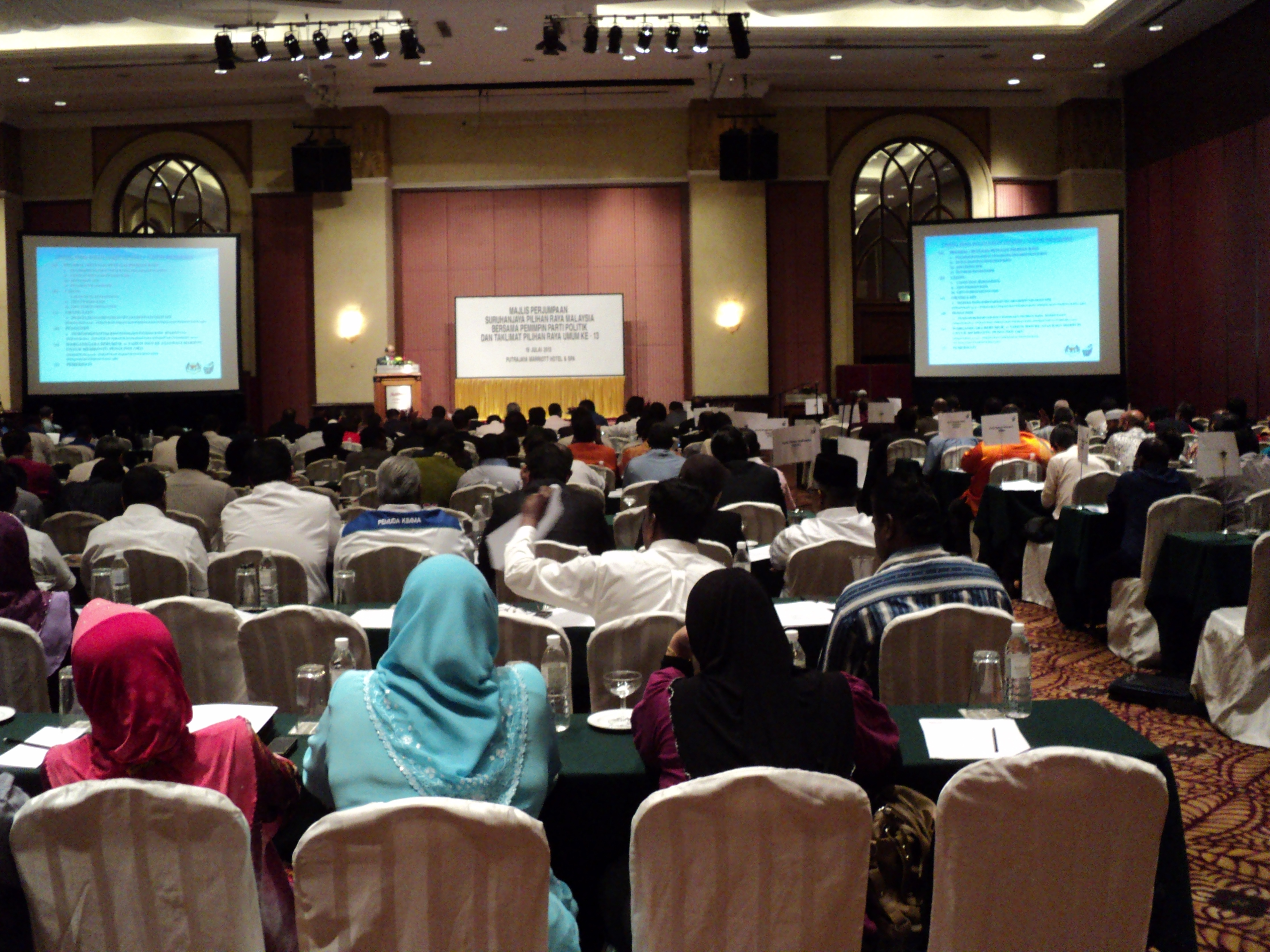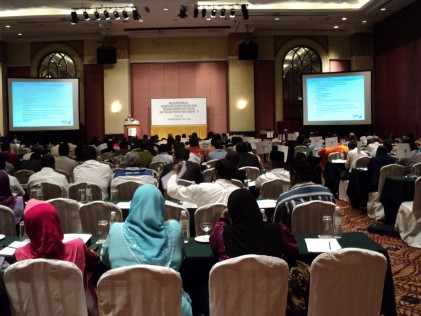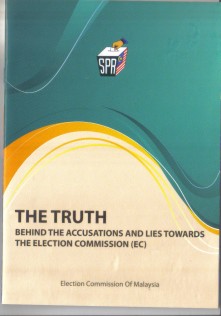The Malaysian Election Commission (EC) today met with all political leaders at the ‘Pertemuan Suruhanjaya Pilihan Raya Malaysia Bersama Pemimpin Parti Politik dan Taklimat Pilihan Raya Umum KE-13’ at the Marriott Hotel Putrajaya, IOI Resort Putrajaya.
The event provided detailed clarifications on various issues including the use of indelible ink, voter registration, elections process and conducted a demonstration on how the election process will be carried out.
In a publication “The Truth” distributed to the participants the EC provided answers to the many questions posed to the Election Commission.
The following is an extract of that publication.
Allegation 1:
The EC deliberately adjusts the boundaries of State and Parliamentary constituencies without the approval of the Parliament, with the intention of increasing the number of voters in a given constituency to enable Barisan Nasional to win in the 13th General Elections (GE-13)
This allegation is malicious and has no basis at all. The EC has never made any changes to the boundaries of State or Parliamentary constituencies as such changes can only be made when there is a review of the constituency boundaries as provided for, under Article 113 of the Federal Constitution. The EC had already issued a statement to the effect that the review of electoral boundaries will only be undertaken after GE-13. The EC will issue an official statement as to when the review will commence at the appropriate time.
What the EC actually did was to correct the mistake it made in placing the locality along with the voters in that locality in a wrong constituency. These mistakes had occurred in the past, possibly because the placement of localities in a constituency was done manually prior to 2004. Thus, under sub-regulation 25(3), Election Regulations (Registration of Electors) 2002, the Chief Registrar is vested with the power to correct such mistakes. The Chief Registrar had therefore placed the locality along with the electors in that locality in the constituency where it should be rightfully.
Only after the EGIS system (Electoral Geographical Information System) was adopted in 2004 did the EC realize that several localities and the electors placed in these localities were in the wrong constituencies. Using the powers vested under the Chief Registrar, the EC placed the localities in the constituencies where they should be rightfully. This exercise involved a total of 19,342 electors in several constituencies.
The localities along with the electors must be placed in the right constituencies as they exist in the field. It must be emphasized here that the placement of localities in the right constituencies does not involve changes to the boundaries of any constituency, be it State or Parliamentary. In fact, by placing the localities in the right constituencies, the electors will be able to vote in the right constituencies, both State and Parliamentary, and in the right polling districts based on their respective addresses.
After these corrections were made, the EC officially informed through notification letters that were addressed to leaders of all political parties in the affected constituencies. The EC assumed that the political parties, through their leaders at the polling districts and the state constituencies, were aware of the corrective actions taken by it and would therefore inform the affected electors in their respective constituencies.
However, based on the feedback that the EC received from the electors, many were not aware of the corrective actions taken to place the locality they are in the right constituency. As a result and in view of the approaching GE-13, the EC will write to all the affected electors throughout the country notifying them of the changes in their constituencies.
Thus, the EC would like to reiterate that the action taken to place the localities in the right constituencies based on the actual location of these localities on the ground, does not involve any changes to the boundaries of the constituencies, both state and federal. Those who need further clarification on this matter can get in touch with any of the EC Offices.
Allegation 2:
The Hon. Tan Sri Abdul Khalid bin Ibrahim was illegally transferred by the EC to another constituency
Allegations that The Hon. Tan Sri Abdul Khalid bin Ibrahim was transferred illegally by the EC to another constituency is untrue and baseless. The EC had given a detailed explanation to Members of the Parliament on 16 April 2012 with regards to this matter. However, this matter continues to be manipulated to mislead the public who may not understand the issue of corrections made to the placement of localities within a polling district, which in turn lies within a State constituency which in turn lies within a Parliamentary constituency.
In the case of The Hon. Tan Sri Abdul Khalid bin Ibrahim, the EC took the corrective action to place the locality in which Hon. Tan Sri’s name appears, along with others, in the right constituency in accordance with sub-regulation.
With the implementation of EGIS in 2004, the EC realized that the locality ‘Jalan 16/2’ was placed in the wrong constituency. In line with the corrective actions that were being taken in other constituencies throughout the country, the EC made the correction and placed the locality ‘Jalan 16/2’ Seksyen 16, Petaling Jaya under the Parliamentary constituency of P. 121 LembahPantai, Federal Territory based on the location of that locality on the ground. This action does not involve any changes to the boundaries of constituencies, both State and Federal. Those who need further clarification on this matter may visit the the EC Headquarters or the Selangor EC Office or the Federal Territory EC Office.
Allegation 3:
EC has failed to clean up the electoral roll. A total of 42,051 doubtful voters are still in the current EC electoral roll
As part of its continuous effort to clean-up the electoral roll, the EC sent the Principal Electoral Roll (PER) with12.5 million registered electors to the National Registration Department (NRD) on July 2011 for a comprehensive review for the purpose of confirmation and verification.
In September 2011, the NRD informed the EC that of the total of 12.5 million electors, there were 42,051 names of electors on whom they do not have clear and reliable information. This means that the names of the 42,051 electors are in the records of the NRD. However, these electors cannot be contacted because of the absence of address though the NRD would like them to come and update their latest status. At the same time, they have not been to any of the NRD offices to update their status. As a result, the EC decided to categorize the 42,051 electors as doubtful due to the absence of the latest information on their status.
Following this, to ensure that the rights of the registered electors are guaranteed under the Constitution, the EC took the right step in not deleting their names from the electoral roll without confirmation from the rightful department, the NRD. Instead, the EC took the initiative to display all of the 42,051 names for a period of 3 months to provide an opportunity for the public, especially electors to come forward to update their information at the NRD and the EC. This would enable the NRD and the EC to update the status of the elector and remove him or her from the list of doubtful electors.
During the same period, the EC also distributed the names of these 42,051 electors to the headquarters of all major political parties, as well as political leaders. The EC hoped that they will get confirmation and feedback on their address or their latest status. Unfortunately, the response received by the EC from political parties and the public during the three months was disappointing. On 28 March 2012, the NRD informed the EC that based on detailed ongoing reviews the number of electors with dubious status was reduced to 40,803 people. This is due to the fact that there had been individuals who went to the NRD to update the information on their identity cards, while others, as heirs, came forward with evidence to the NRD on the death of family members or their relatives.
The law does not allow any name in the electoral roll to be deleted without confirmation of their status from the NRD. Thus, the names of 40,803 electors of dubious status should continue to remain in the electoral rolls, in order to ensure that their rights are protected under the Constitution. The EC would only delete their names from the electoral roll after official confirmation had been received from the authority, that is the NRD, on whether the individual has died or lost his or her citizenship status, or is disqualified for other reasons as provided for under the Federal Constitution. Therefore, as long as the final confirmation has not been obtained from the NRD, the names of all the 40,803 electors must be maintained in the Principal Electoral Roll.













